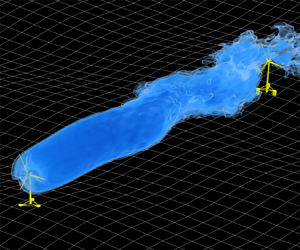Article contents
Resolvent-based motion-to-wake modelling of wind turbine wakes under dynamic rotor motion
Published online by Cambridge University Press: 08 February 2024
Abstract

We propose a linearized deterministic model for predicting coherent structures in the wake of a floating offshore wind turbine subject to platform motions. The model's motion-to-wake predictive capability is achieved through two building blocks: a motion-to-forcing (M2F) part and a forcing-to-wake (F2W) part. The M2F model provides a unified framework to parameterize the effects of arbitrary floating wind turbine motions as unsteady loads of a fixed actuator disk, requiring only the radial distribution of the aerodynamics force coefficient on the blade as input. The F2W model is derived based on a bi-global resolvent model obtained from the linearized Navier–Stokes equations, using the time-averaged wake of a fixed wind turbine as input. In addition to its capability of predicting sensitive frequency ranges, the model excels linear stability analysis by providing spatial modes of the wake response in a motion-specific and phase-resolved manner. The model successfully predicts the wake pulsing mode induced by surge, as well as the similarity and difference of the wake meandering modes caused by sway and yaw. Large-eddy simulations under different inflow turbulence intensities (TIs) and length scales are further conducted to analyse the wake meandering triggered by the simultaneous excitation of free-stream turbulence and sway motion. The results show distinct frequency signatures for the wake dynamics induced by ambient turbulence and sway motion. The inflow TI is found to have a stabilizing effect on the wake, reducing the motion-induced wake responses. Such a stabilizing effect is captured satisfactorily with the proposed model, provided that the effective viscosity is calibrated properly using the data from the fixed turbine wake under the corresponding turbulent inflow.
JFM classification
- Type
- JFM Papers
- Information
- Copyright
- © The Author(s), 2024. Published by Cambridge University Press
References
- 2
- Cited by





